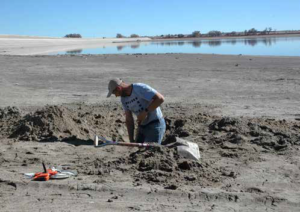“Lakespert” – I Really Dig Lakes!
Steve Lundt, CLM

One nice thing about the arid West, you get the chance to be at one with the lake sediements with just a Secchi Disk (it had a tape measure to show how deep my hole was).
In some ways, lake sediments can almost be as ambiguous as groundwater. It is hard to physically see it, feel it, or understand all the complexities throughout the water-to-sediment interface. There is so much going on in our lake sediments. That is why I like to dig a hole every once in a drawdown.
You can’t fully understand your lake or reservoir without getting dirty. You can learn some key basics by collecting sediment. Over the years, I have done gravity cores, Ekman grabs, and even dug a hole to look for the pre-reservoir, buffalo wallow layer. I do know what my lake sediments smell, feel, and look like thanks to a complete sampling plan. However, I am only a “lakespert.” I know when it is time to call in the real experts.
When I need data, I turn to my local state university’s soil testing laboratory. One word of advice, be patient on getting the lab results back. Those multi-element phosphorus extraction tests are tedious and complex. The wait is worth it though. Having a clear understanding of what is in your sediment is critical if you are dealing with internal loading, considering in-lake alum, determining where to dredge, or working on an annual phosphorus budget.
Besides finding a reliable lab, NALMS is a great resource for finding experts across North America who can interpret your sediment data. Over the years, I have attended informative symposium sessions about dating sediment cores and documenting diatom fossils that help tell a water quality story. Finding these types of sediment experts can be more challenging than the actual collection of the sediment sample. Ask around. Use your NALMS contacts and find the right people. This will help with understanding how your lake’s water quality changes over time and increase the success rate of your lake project.
One last bit of advice, sample your sediments in as many locations as you can afford. Similar to water quality, sediment quality can change spatially. Even in the smallest of lakes. Sample different locations within your lake to understand the full picture. A great example is the lake I work on that has a 20-foot drawdown each fall that concentrates the organic matter to the deepest location. I discovered I had a range of total phosphorus from 114 to 2,230 mg/kg within my 20 samples.
I know it looks like I am digging a dark grave in the photo (kind of a cool idea for a lake lover), but I strongly believe that gathering data from your sediments will help shed light on your lake’s past, present, and future. Go dig a hole and see what you find.
 Steve Lundt, Certified Lake Manager, has monitored and worked to improve water quality at Barr Lake (Denver, Colorado) for the past 19 years. Steve is active with the Colorado Lake & Reservoir Management Association and is a past Region 8 director for NALMS and an active member since 1998.
Steve Lundt, Certified Lake Manager, has monitored and worked to improve water quality at Barr Lake (Denver, Colorado) for the past 19 years. Steve is active with the Colorado Lake & Reservoir Management Association and is a past Region 8 director for NALMS and an active member since 1998.

